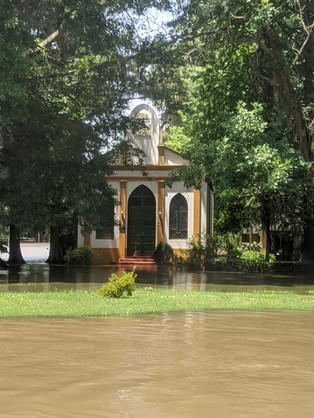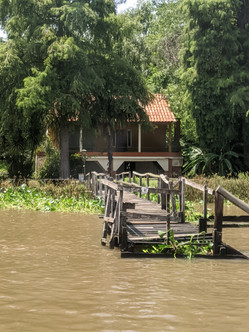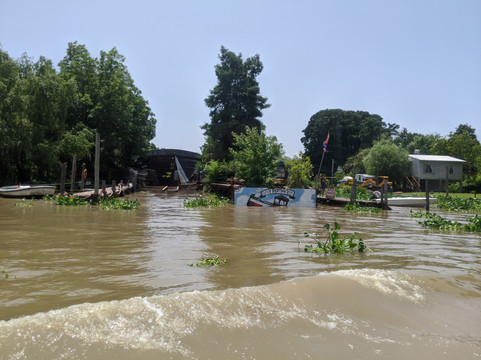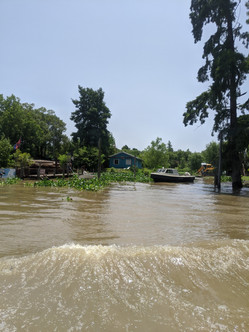A Pedacito of Tigre Delta in Buenos Aires, Argentina
- Michael Acevedo

- Jul 5, 2020
- 4 min read
Updated: Jul 1, 2021
Tigre is a city in Buenos Aires Province, Argentina, which is about 17 miles north of Buenos Aires city. Tigre lies on the Paraná Delta and is a popular destination for many Argentinians and tourists (like me!).
The city sits on an island created by several small streams and rivers and was founded in 1820, after floods had destroyed other settlements in the area, then known as the Partido de las Conchas.
The area's name derives from the “tigres” or jaguars that were hunted there, on occasions, in their early years. The area was first settled by Europeans who came to farm the land, and the port developed to serve the Delta and to bring fruit and wood from the Delta and ports upstream on the Paraná River.

I opted to go to Tigre on a small group tour with roundtrip transportation from my hotel in Buenos Aires. It was a beautiful morning to be outdoors and I was excited to have a relaxing drive and boat ride. On the way, we stopped at Playita de Olivos to stretch our legs, take a breather, and marvel at the sight of Rio de la Plata.
The river is about 180 miles long and it widens from about 1.2 miles at its source to about 140 miles at its mouth. It forms part of the border between Argentina and Uruguay, with the major ports and capital cities of Buenos Aires and Montevideo on its western and northern shores, respectively.
The coasts of the river are the most densely populated areas of Uruguay and Argentina. It is so wide from this park that it feels more like you are looking out into the ocean since Uruguay can't even be seen!
Our next stop was the town of San Isidro. The town was very tranquil and peaceful, a very different pace from Buenos Aires. The cobblestone streets are lined with old small buildings and there is a smattering of small parks and plazas throughout.
One of the beautiful plazas is Plaza Mitre which is adjacent to the Catedral de San Isidro. Built on the site of a 1706 chapel opened by the city's founder, Captain Domingo de Acassuso, the cathedral was designed by French architects Dunant and Paquin, and inaugurated on July 14, 1898.
Constructed in neogothic style, it stands over 200-feet tall. Its base is a Latin cross. Its walls are built from materials like rock and bricks, and it has stained glass windows. In the last 3 years, some architects started a plan to remodel it, with the objective of bringing back its original splendor. Whenever I get a chance to see a beautiful cathedral, I always take it.


After a few minutes in San Isidro, we set off on the final leg of our drive to Tigre. We arrived at a fairly busy port, Terminal Fluvial Tigre, filled with lots of families eager to get out on the water and enjoy the beautiful day.
There were many boats available so I can imagine if you decide to take a day trip over to Tigre, you can pick out one to suit your specific needs. Our vessel was narrow and long with cushioned bucket seats in an air-conditioned cabin and featured an outdoor viewing area perfect for taking pictures.
The boat ride was very relaxing and comfortable. Since we weren't a big group there were lots of empty seats and I sat in my own row at a window. We got to see lots of houses, commercial, and government buildings built right on the banks of the river.
During my visit, the water level was very high, where many of the properties were flooded. There were lots of "For Sale" signs because of this, unfortunately. But, even with the flooding, we saw lots of people going about their day like usual and even kids swimming in what is their front yard.
This really reminded me of being in the floating markets in Thailand. Each of the members of the community offers services to its neighbors and everyone gets around by boat or canoe. There are grocery stores, hotels, a church, and several residents that offer their services.
While some of the houses were completely flooded, several others were located far back enough where the elevation was a bit higher; many were on stilts. Apparently, properties here are relatively cheap but I can't imagine the cost of insurance...
You could easily get lost navigating the many tributaries and rivers. The trip was peaceful and relaxing - I fell asleep on the way back (did I just pay for a nap?...). Next to the port is a small amusement park with some pretty cool-looking rides.
I can see why Tigre is a popular place for Argentinians on the weekends and how tourists, like myself, could easily spend a day here. The next time I am in Buenos Aires, I will definitely spend at least one night in Tigre so I can explore more of the city and its offerings.
Want to know more? Are you interested in becoming a contributor for Pedacitos? We'd love to hear your stories! Send me a message and I will get back to you!



















































































































Comments